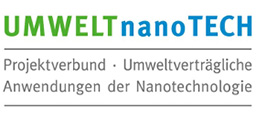UMWELTnanoTECH
ENVIRONMENTALLY COMPATIBLE APPLICATIONS OF NANOTECHNOLOGY

9 Ultra-fast electrical energy storage devices based on nanodiamond composites
Field of work:
Energy Storage DevicesThe provision of electric energy storage devices with a high energy density accessible upon charging and discharging within sub-seconds to seconds is a major pillar in the development of an infrastructure allowing the efficient use of renewable electric energy sources.
Electric energy for mobile applications such as electric vehicles is usually stored in rechargeable batteries (e.g. lithium ion based). However, these devices have a number of disadvantages. This includes their low cycle stability and the so far restricted power density, resulting in only a small fraction of the storage capacity actually being used upon fast charging/discharging.
Supercapacitors play a major role in the area of high-efficiency power storage devices because they are clearly superior to rechargeable batteries in terms of cycle stability and power density. Currently, supercapacitors based on active carbon electrodes with an efficiency of 90-98 %, energy densities up to approx. 6 Wh/kg and storage sizes of up to 52 kWh are available in devices. However, supercapacitors have energy densities which are one or two orders of magnitude lower than those of Li-ion storage units. Thus, large spatial volumes have to be provided in order to store comparable amounts of energy.
The goal of this project is therefore the development of innovative electrodes for supercapacitors with a high power and a high energy density. For this purpose, starting with nanodiamonds which can be produced in a cost-effective way in large quantities from organic precursors, composite electrodes are to be created and studied. If combined with suitable electrolytes, the performance parameters for supercapacitors and their applications are expected to be expanded considerably. Initial results with modified nanodiamond materials show a good integration into existing matrix materials and now allow profound characterisation and optimisation of these composite electrodes. With the new nanodiamond-based electrode, the project aims at an increase in power density by an order of magnitude and a raise in the effective volumetric energy density of the storage components at high charging rates by a factor of four. As a result, gaps in the available characteristics of electric energy storage can be closed. This enables, among other things, the storage of braking energy (e.g. in vehicles). In addition, application areas such as wind power generation are being served (slip control, control of the rotor blade alignment). In some applications, these new storage devices can also replace lithium ion storage devices, particularly when requirements are moderate for storage density as well as self-discharge and high for cycle stability and service life.



